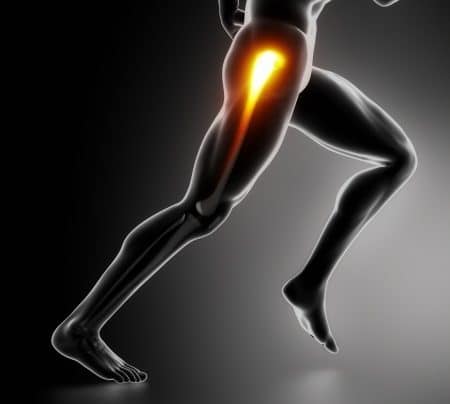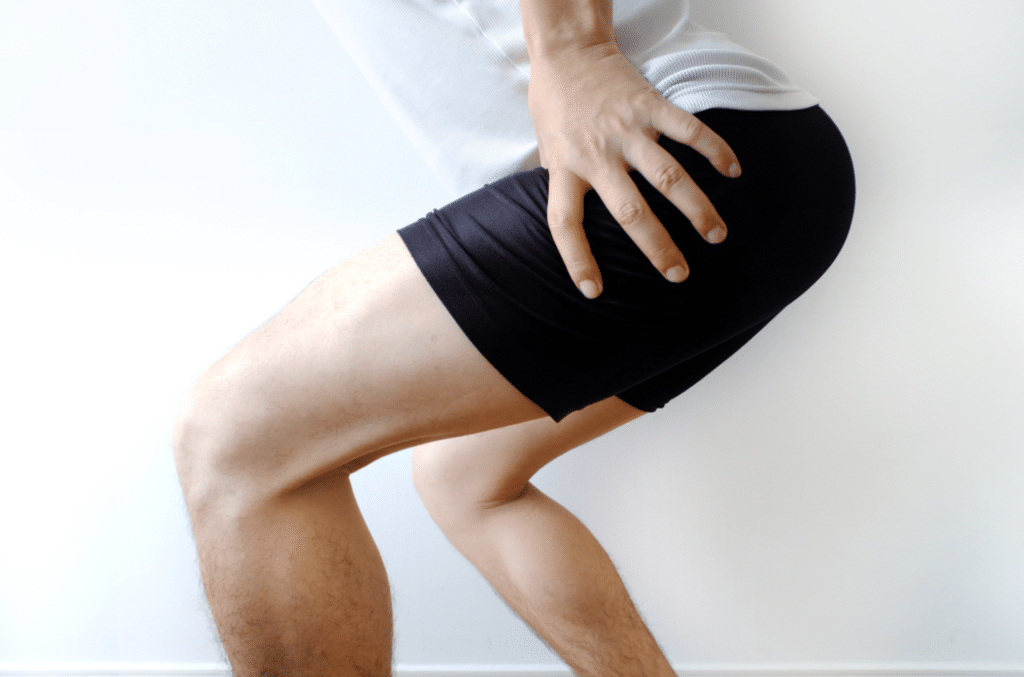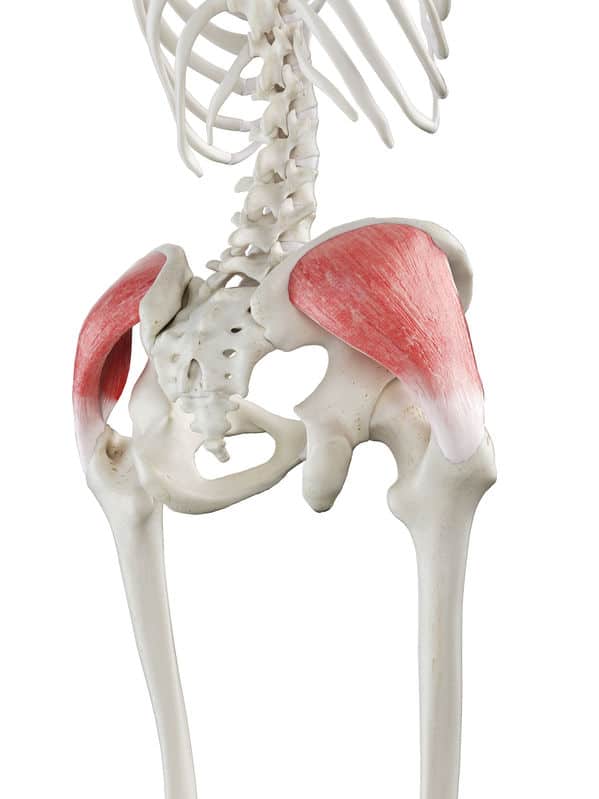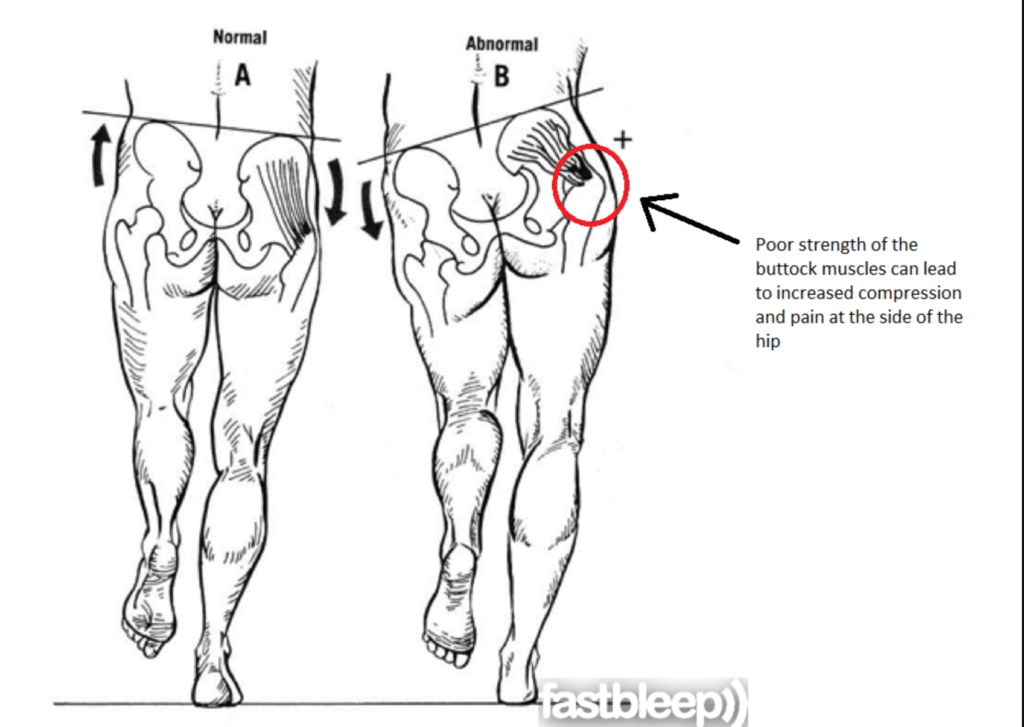
Hip pain, especially pain on the outside of the hip can become quite frustrating to a runner. There are a few causes of pain on the lateral or outer of the hip… and one muscle, in particular, is quite the trouble maker.

Running is one of the most popular ways to stay in shape and improve fitness. It’s easy to see why – you can take it anywhere, it requires little equipment, and you don’t need a lot of coordination to do it. Left, right, repeat. But when runners get hurt, and routines are off, annoyance sets in. I know because I am one of those runners. My hip pain reared its ugly head off and on for years, leaving me frustrated and longing for a good run.
Millions of people run on a regular basis, and although it’s a great way to stay active, most runners will experience an injury, or several, along the way. Runners are their own worst enemy — as many of these injuries are training errors. With running injuries, most people think of knee, foot, and ankle pain. In my experience, pain around the hip is also a fairly common overuse injury in runners—especially pain on the lateral aspect (outside) of the hip.
Why does the outside of my hip hurt?
Hip pain in runners occurs more often than you’d think. When your hip is sore on the outside, and if you’re a runner, it is usually one of a few problems:
- gluteal tendinopathy,
- gluteus medius syndrome,
- IT Band dysfunction.
Let’s dig into the first one. Few people have heard of it, but gluteal tendinopathy is the most common cause of running-related outer (lateral) hip pain.

What is Gluteal Tendinopathy?
Gluteal tendinopathy is when a muscle or tendon acts up, creating pain on the outside of the hip. Tendons are the attachment of muscles to bone. In a situation where tendinopathy arises, the tendon attachment develops characteristic changes we can see under a microscope. Those changes are often precipitated by putting too much load onto a tendon that wasn’t ready for it. That’s why I stated earlier that many tendinopathies are due to training errors. The changes that occur during gluteal tendinopathy include new blood vessel and new nerve formation. They arise as part of the tendinopathy process… and those nerves are source of soreness and pain.
When you run, each strike of your foot on the ground creates big compressive forces that travel up your leg, and into your hip, putting the tendons under stress. The strong tendons of the gluteal muscles insert on the outside of your hip, at a place called the greater trochanter. So….activities that irritate these gluteal tendons are likely to lead to hip soreness on the outside. Gluteal tendinopathy is the medical term for irritation and “degeneration” of the tendon on the outside of the hip.

Sometimes this pain goes hand in hand with a biomechanical issue, meaning your basic running form is compromised. If you have underlying core or glute weakness, your body may be compensating, and your gluteus muscle is unable to do its job properly. If you have an excessive hip drop, or overstriding, you might stress your gluts into painful dysfunction. You might not even know your body is moving in a risky way that can cause pain, until it’s there – a sore outer hip. Many physiotherapists who treat runners have high speed video equipment to help diagnose someone with a poor running form.
What Does Lateral Hip Pain Feel Like?
In other words, how do I know if I have gluteal tendinopathy (GT)? Lateral hip pain due to GT can feel like an ache, burning, or dull pain and the area around the tendon will be tender. Sure, patients feel lateral hip pain on the outside of the hip, but it can refer down the leg or even to towards the groin. The pain can range from mild to severe. Patients sometimes notice a tender to touch- a hot spot- when they press on the bony part of the outside of the hip. This spot is the greater trochanter, which is where the tendon inserts.
Some patients say that their running-related lateral hip pain feels like stiffness in the morning, especially if they have had a big run, or a lot of activity the day before. Usually going upstairs makes it worse and running hills can be really intense, or impossible. In severe cases, even walking and sitting can be painful.
How Do You Treat Lateral Hip Pain?
Treating lateral hip pain caused by running involves fixing the problems that started it. You may need to cut back on training intensity for a little while. Targeted exercise and prescribed stretching can help. Sometimes icing after exercise or massage will make your hips feel better.
Time is your friend. If you are doing the right things – proper exercise, reasonable activity, a little ice now and then, your gluteal tendinopathy should improve.
How Can I Avoid Feeling Outer Hip Pain with Running?
To avoid outer hip pain with running, consider these tips — > stretch, strengthen, and smart training
Stretch
A flexible balanced body is a better moving body. Baseline stretching, yoga, or assisted stretching are great additions to your running regimen. An important note – if you have developed gluteal tendinopathy- avoid your typical IT Band or glut stretches that compress the tendons on the outside of the hip. Aggressive stretching in cases of gluteal tendinopathy can make the symptoms worse. When in doubt, ask.
Strengthen
Having a strong core and gluteal muscles can lower the risk of developing a running-related outer hip injury by keeping your pelvis stable. The gluteus medius is a muscle to pay attention to. It is located on the side of your hip and runs down to the outer part of your thigh. This muscle is key in lifting your leg out to the side but is also important to the mechanics of running.
As you run, the gluteus medius stabilizes your pelvis, keeping it level, as your alternating feet strike the ground. Weakness here can cause small shifts in alignment that add up to big problems. Especially in long-distance running or on challenging terrain. The good news is that there are simple at-home exercises to target this specific area and keep you on the road to running.
Smart Training
Increasing mileage too quickly, max speed sprints, suddenly adding hills, or not allowing adequate rest and repair time, will make you vulnerable to running-related outer hip pain. Train smart and listen to your body. Overtraining syndrome is a real thing, and it can interrupt or end your running career if you push way past your typical zone. Avoiding common overuse injuries is another reason why all elite runners use a polarized training program.
Do you have questions regarding an Orthopedic injury or longevity?
Do you want to talk to an expert who can listen to you for 45-60 minutes and explain the options in detail?
Dr. Howard Luks offers remote guidance sessions to review your X-ray or MRI images and explain your options.
Dr. Luks has also received hundreds of requests for educational sessions on the topics discussed in his book, Longevity Simplified.
Lateral hip pain can be seen in stress fractures too!!
This is worthy of mentioning here. The majority of people with pain on the outer side of the hip will have pain due to the gluteus medius tendon. Hoewever, on a few occasions in my career I have seen runners with stress fractures of the upper femur, or the femoral neck present with pain on the outside of the hip. Most doctors, me included earlier in my career, usually expect to hear of severe groin pain when we are dealing with a possible femoral neck stress fracture. The treatment of femoral neck stress fractures and tedninopathy are very different, so feel free to bring this up with your doctor.
Lateral hip pain is not often due to the ITB
The ITB is most over-blamed tendon in runners with leg pain. Around the hip, the ITB crosses over the gluteus medius attachment. So the pain felt when touching that area is often blamed on the ITB, when in fact the pain is coming from the gluteus which lies beneath the ITB.
Avoiding Lateral Hip Pain in Running is Possible
By understanding what triggers gluteal tendinopathy and knowing what to do when you start to feel your outer hip hurt, you can make long strides in your journey towards optimal running health and well-being. You want a body that performs well for the long haul, so pay attention to the signals your body sends, and rest assured, you will be able to go the distance. Keep the 10% rule in mind. You should not increase your pace or distance more than 10% per week. This will minimize the risk of developing an overuse injury.
Once you have an established case of gluteal tendinopathy it is important to see a physical therapist who is used to working with runners. They will perform an assesment of your running form and cater a program to suit your needs. The treatment of gluteal tendinopathy will depend on how you present to their office. If it is early in the course then they might start with a more aggressive program and adjust your form. If you are more disabled they will start with a program to allow the tendon to calm down first.
It is usually OK to continue running despite having gluteal tendinopathy. Just take it slow, continue with your rehab and don’t push your cadence, distance or pace. This is not the time to advance your training program.











